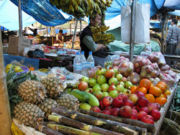Food/Intro
 . People are moving from farms into cities at the rate of over a million a week [1], and their appetite for meat is growing[2]. These trends means that food demand is rising, but there are fewer farmers to supply it. It would indeed seem that we are heading for a food crisis.
. People are moving from farms into cities at the rate of over a million a week [1], and their appetite for meat is growing[2]. These trends means that food demand is rising, but there are fewer farmers to supply it. It would indeed seem that we are heading for a food crisis.
But this analysis misses a key point: that there are far more efficient ways to produce food than the ones now in wide use. Any food shortage is really a shortage of applying know-how to food production. In the case of soil depletion, for example, while it is true that certain farming methods deplete soil, there are other methods (like permaculture, discussed below) that rapidly and reliably increase the fertility of the soil.
As for our growing appetite for meat: the argument is that it requires 16 kilos of grain to produce one kilo of beef, so to preserve food and avoid a food crisis, we must all become vegetarian [3]. This makes the assumption that cows must be fed grain. Cows eat grass. Grass is not edible by humans, so no useful food resources are being wasted, and beef from grass-fed cows has a better nutritional profile than from grain-fed animals[4]. Similar logic applies to other kinds of meat.
Abundance of agricultural resources
This planet has 31.8 trillion m2, of fertile land  . This can be greatly expanded if necessary by irrigating deserts and introducing sustainable farming practices that rehabilitate soil. (For example, 3 billion m2 of land in Niger was reclaimed for farming recently[5].) The UN estimates 41.4 trillion m2 available for non-irrigated agriculture alone [6].
. This can be greatly expanded if necessary by irrigating deserts and introducing sustainable farming practices that rehabilitate soil. (For example, 3 billion m2 of land in Niger was reclaimed for farming recently[5].) The UN estimates 41.4 trillion m2 available for non-irrigated agriculture alone [6].
However, improving food supply has much more to do with increasing the yield of existing farmland than creating new farmland [7]. This is because the system of agriculture makes a huge difference to the amount of land needed; the average Canadian requires over 12,000m2 [8], while permaculture systems regularly produce enough food for a person on less than than 400m2. This means our 31.8 trillion m2 can grow enough food for 79.5 billion people, well over ten times the current world population. (And this does not even factor in the more efficient controlled-environment methods discussed below.)
To sustain a growing population in a way that is viable in the long-term, whatwe need is 'sustainable intensification' [9][10][11]. This refers to a method of agriculture that gives higher yields than industrial monoculture, has less impact on the environment, uses less water and requires fewer inputs. Several different such methods are explored below.
